The bi-annual Agritechnica show held in Hannover Germany will run from 8 to 14 November. Almost entirely indoors, Agritechnica is the largest show of its kind in the world.
With 2,897 exhibitors from 47 countries, it attracts in the region of 450,000 visitors from 88 countries. Well over 100,000 of these are visitors from nearly 90 countries.
Irish visitors to the previous Agritechnica Show in 2013 were reported to number 5,800.
The Irish contingent was still the fifth highest among the show’s foreign visitors. This was ahead of the British group, which came to around 5,000.
TRACTORS
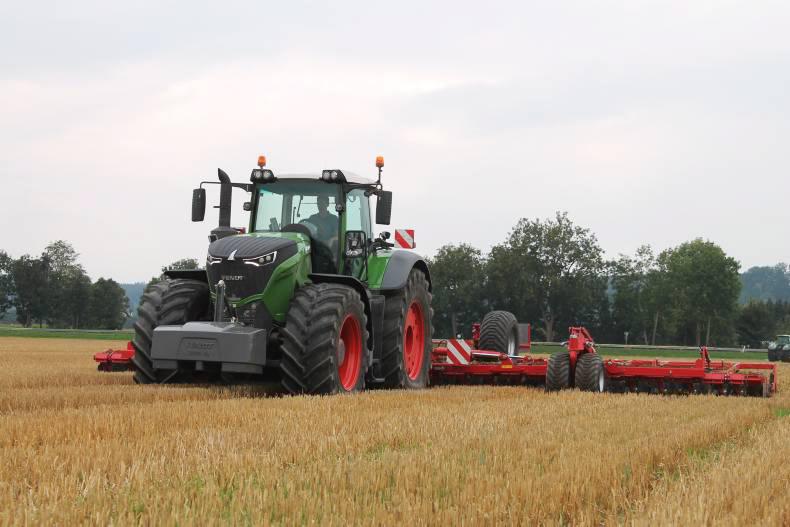
Fendt
Just last year Fendt provided a sneak preview of its new flagship tractor range, the Fendt 1000 Vario series. Apart from a picture and what horsepower was going to be available, very little details were released.
For many, it will be the first time to actually see Fendt’s new 1000 Vario series in the flesh. Four models, the 1038 Vario, 1042 Vario, 1046 Vario and 1050 Vario, provide a range of horsepowers from 380hp to 500hp.
The manufacturer was keen to point out that the new 1000 Vario is not a beefed-up 900 series, but an all-new tractor with TA400 transmission and six-cylinder 12.4 litre MAN engine. The working range for the engine is just 650rpm to 1,700rpm, where it says it achieves optimum efficiency. Maximum torque is a huge 2,400nm (1050).
To comply with emission regulations, exhaust gas regulation (EGR) and a variable geometry turbo are used in conjunction with an SCR (AdBlue).
A new concentric air system sees Fendt redevelop its cooling package, positioning the cooling fan in front of the radiator. Pushing denser cold air through the cooling package with a hydraulically driven fan sees an efficiency gain of 25% to 70%, according to Fendt.
Fendt has put its clever hat on in developing the TA400 transmission for the new 1000 series. One hydrostatic pump drives two motors within the hydraulic element of the Vario transmission.
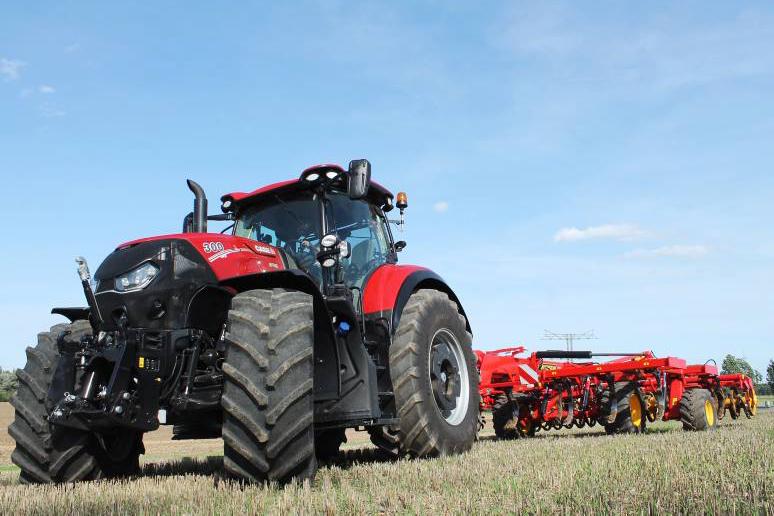
CaseIH Optum
Filling a gap between the current Puma and Magnum ranges is the new two-model Optum CVX range from CaseIH. These new high-horsepower tractors will get their first public viewing at Agritechnica.
The new CaseIH Optum CVX 270 and 300 provide more power in a tractor closer to Puma dimensions. Both are available only with continuously variable speed CVX transmissions.
Powering both Optum models is a fully reworked Tier 4-Final, 6.7-litre NEF engine from FPT. There is no boost facility on Optum models. Rated horsepower of 270hp and 300hp is achieved on both models at a rated speed of 2,100rpm. Maximum power of 313hp is achieved at 1,800rpm on the larger of the two. Quite a bit of work has been done on the tuning side to meet stringent T4-final emission standards and get the extra power out of the NEF engine. This FPT did without adding EGR or a diesel particulate filter (DPF).
Pumping more air into the engine is a single electrically controlled variable geometry turbo (eVGT). Lower-powered Pumas use a standard wastegate turbo. The turbo incorporates some clever features including an exhaust flap which closes to get the engine up to running temperature quicker.
As an option, this can be used as an exhaust brake, operated by a second accelerator pedal on the left of the foot pedal.
Physically, the engine receives a structural sump. The new design eliminates the need for side rails supports.
The Optum’s drivetrain is based on the Puma’s but beefed up to handle the extra power.
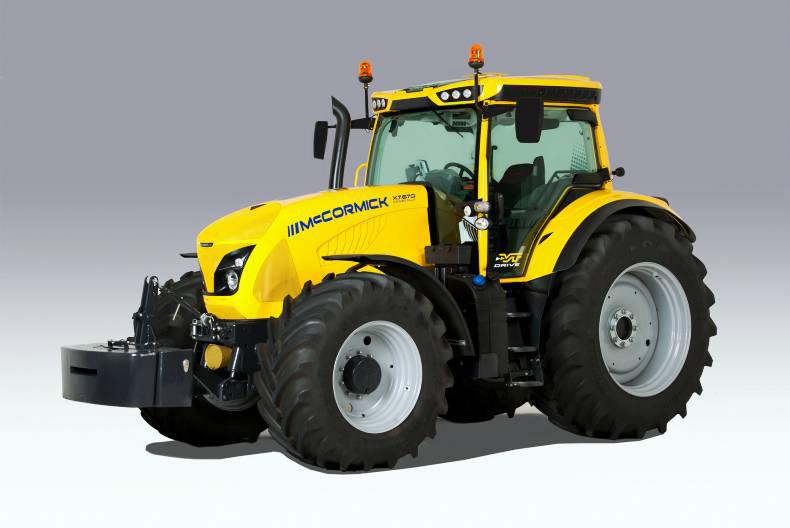
McCormick X8 Series
Breaking the 300hp barrier, ARGO Tractors will launch its new McCormick X8 Series at Agritechnica. The new X8 range features three models with power ratings of 264hp, 286hp and 310hp, all powered by BetaPower Fuel Efficiency, 6.7-litre, six-cylinder engines, equipped with variable-geometry turbocharger technology (from FPT). The X8 Series comes with a well proven four-range ZF continuously-variable transmission.
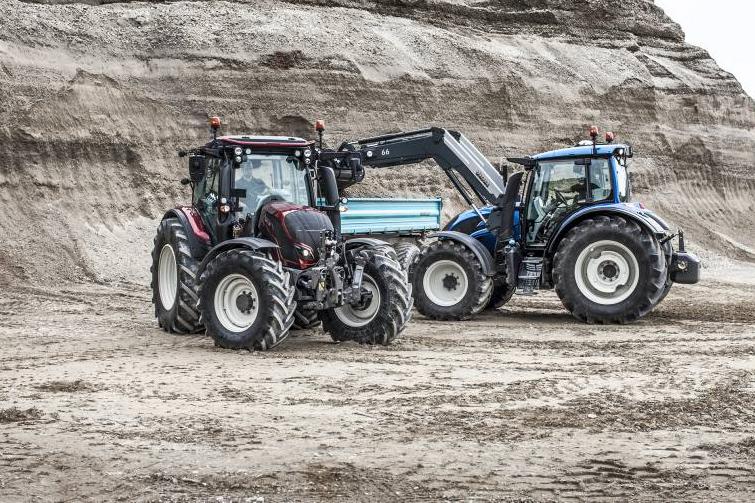
Valtra N Series
Valtra has launched its fourth generation, four-cylinder N Series with six models ranging from 105hp to 165hp (unboosted). The boosted engine horsepowers range from 115hp to 185hp.
The N104, N114 and N124 models are powered by four-cylinder 4.4-litre AGCO Power engines, while the N134, N154 and N174 models have 4.9-litre engines. The SCR system takes care of exhaust emissions without the need for a DPF or EGR system.
Valtra’s Sigma Power technology provides an extra 10hp when the PTO is under sufficient load. In the N174 Simga+ model, the system provides 20 extra horsepower.
All models also feature the transport boost function, which provides extra power when driving on the road.
The N114 and N154 represent Valtra’s traditional EcoPower models in which the driver can select between eco and normal mode. In eco mode, the engine speed is reduced by 10% to 20%, and maximum torque is achieved at lower rpm.
Eco mode reduces fuel consumption by up to 10% compared with the normal driving mode.
The new N-series has inherited much from the larger T-series, most obvious of that being the T-series cab.
Transmission options on the new N Series include: HiTech, Active, Versu and Direct.
The first three are five-speed powershift transmissions, while the Direct transmission is stepless.
The Active, Versu and Direct transmissions also feature load-sensing hydraulics. Customers can select hydraulic outputs of 115, 160 or 200 litres per minute.
The HiTech transmission comes with a gear pump producing 73 or 90 litres per minute.
The hydraulics on HiTech and Active models are controlled mechanically, while those on Versu and Direct models are controlled electronically.
Landini 6 and 7 series
Among the new Landini models ARGO will display at Agritechnica are the Landini 6 and 7 Series V-Shift tractors. These new-generation tractors feature a ZF continuously-variable transmission and all-new metallic blue bodywork.
The range includes three models powered by NEF four-cylinder engines delivering 147hp, 160hp and 176hp (6 Series) and two six-cylinder models with 181hp and 195hp maximum power ratings (7 Series).
All models in this range are equipped as standard with a 12in touchscreen monitor that allows the driver to control the tractor’s performance and operating parameters. The ISOBUS feature complies with industry standard ISO-11783. With the optional precision steering management (PSM) system, an additional 8.4in touchscreen is provided on all models to manage the satellite-based guidance system, EazySteer active steering system and the advanced ISOBUS implement section and task controller functions.
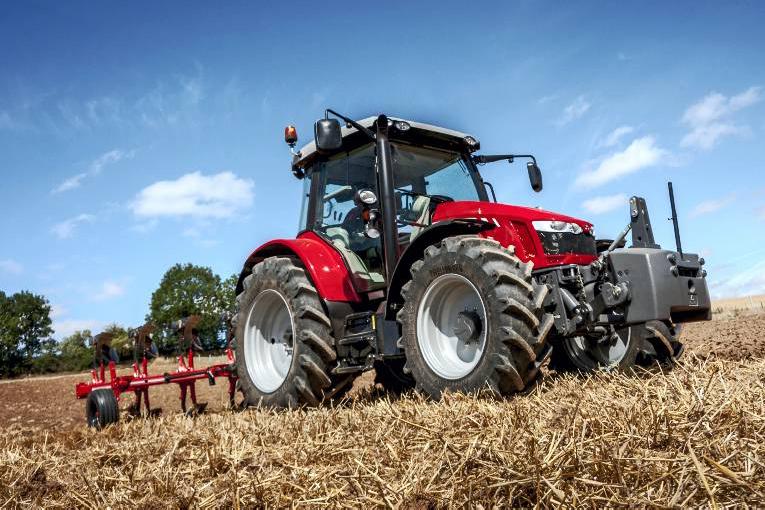
Massey Ferguson
New tractors from Massey Ferguson for Agritechnica include cabbed versions of its Global 4700 Series tractors and new 130hp Massey Ferguson 5713 SL.
Three models from 75hp to 95hp make up the cabbed versions of the 4700 range. All feature three-cylinder AGCO Power T4-final engines, which utilise SCR (AdBlue) emission control.
The standard transmission is a 12x12 mechanical unit but a power-shuttle version is available as an option.
Electronic lift control is standard as is 540rpm pto (optional eco or three speeds).
The new 130hp Massey Ferguson 5713 SL tractor offers a higher level of sophistication with more transmission and hydraulic pump options, as well as a high-visibility bonnet for loader operations. Powering the new 5713 is a T4-Final, AGCO Power, 4.4-litre, four-cylinder engine with unique all-in-one maintenance-free, selective catalytic reduction (SCR) with diesel oxidisation catalyser (DOC).
Transmission includes the firm’s Dyna-4 or Dyna-6 units, while hydraulic options include 58 or 100 l/min open-centre pumps or 110 l/min closed-centre, load-sensing pump.
Lift capacity is quoted at a decent 5,400kg. Standard pto speeds are 540/540 Eco, while 540/540 Eco/1,000rpm is available.
Other options include front-axle suspension, Speedsteer (fast turning system) and the auto-guide 3000 steering option, with the latest ‘Go’ mode.
MACHINERY
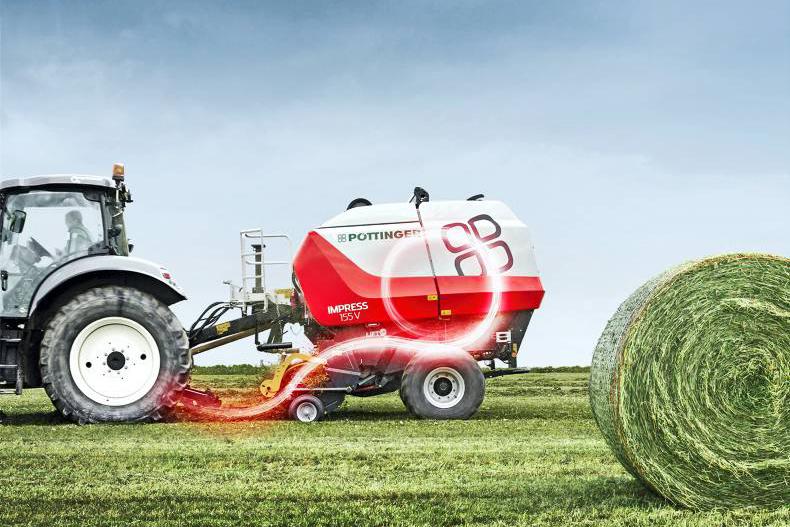
Pöttinger baler
Pöttinger launches several new products at this year’s Agritechnica. Having previewed its round-baler range last year, Pöttinger officially launches its new IMPRESS round-baler at Agritechnica. The IMPRESS will be available in Master or Pro versions, with 16 or 32 knives, respectively, in the overhead knife bank. Availability is not expected until 2017.
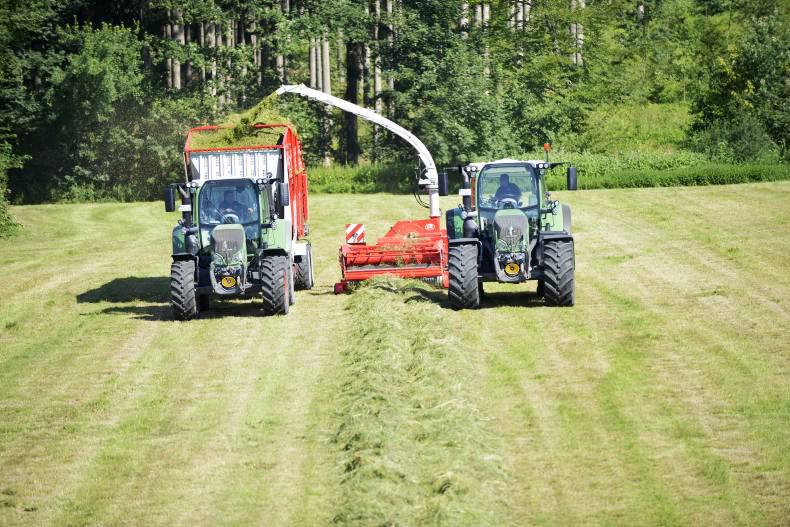
Lely Storm
Among the many new products from Lely is the Storm P300 trailed silage harvester. This features a new 2.2 metre pickup and a new intake for the chopper. All machine functions, including the spout, are now hydraulic and gone is the on-board hydraulic system.
Also new from Lely is a blade sharpening system for its PR and XR silage wagons.
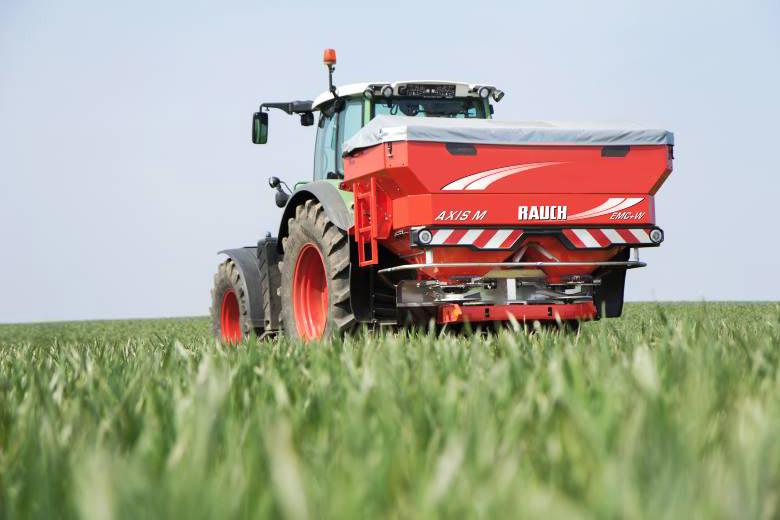
Rauch AXIS with new EMC control
Rauch continues to innovate and has just introduced a new electronic massflow control (EMC) system, which provides automatic metering of the fertiliser. This is available on mechanically driven AXIS M 20.2 EMC(+W) models and hydraulic AXIS H EMC(+W) models.
The new EMC-2 measures and controls the actual fertiliser flow automatically using contact-free high-tech sensors. The tried-and-tested technology is usually used for the drives of E bikes or Segway personal transporters. Using so-called magnetostriction, the change of the magnetic field at every drive shaft of the spreading discs is measured separately and converted into corresponding torque signals. Using EMC-2, the fully automatic fertiliser metering has become even more user-friendly, precise and safe.
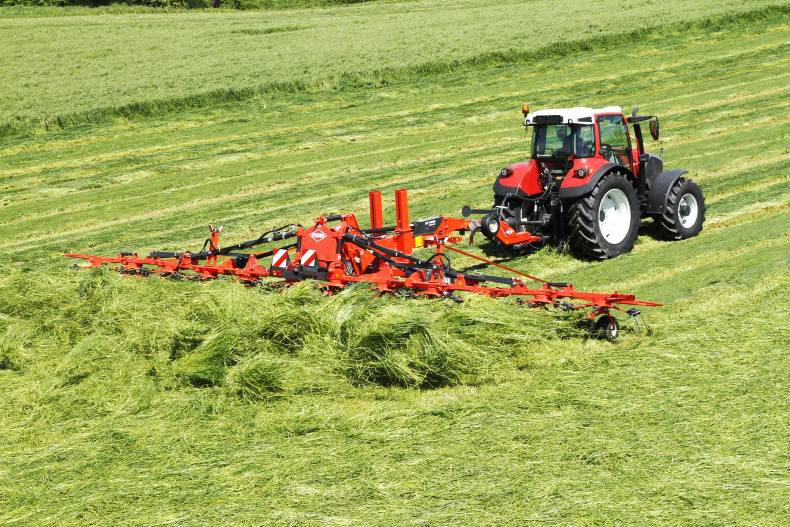
Kuhn trailed tedders
Kuhn introduces 13 new products at Agritechnica. Among those are new 13 metre and 17 metre trailed tedders. The GF 13012 and GF 17012 are a new design from the manufacturer. The rotors can contour the ground while the frame locks on lifting to provide high headland clearance.
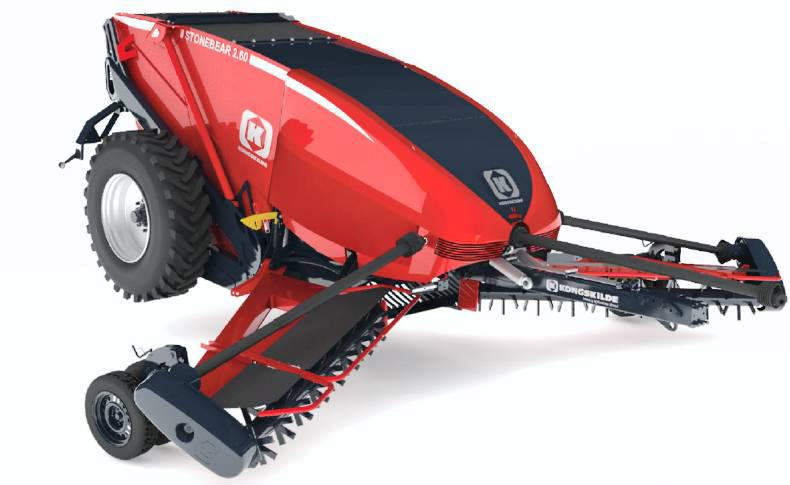
Kongskilde Stonebear 2
Kongskilde launches several new and improved products at Agritechnica, including a new XLD plough body for its Overum ploughs (300mm deep ploughing) and its next generation Stonebear 2 stone collector.
The Stonebear 2 comes with a working width of 6.2 metres and a significantly higher hopper capacity. Stone picking rate is quoted at 1.3 tonnes per minute. Kongskilde says it can handle stones of up to 500mm in diameter and it has a hopper tipping height of three metres.
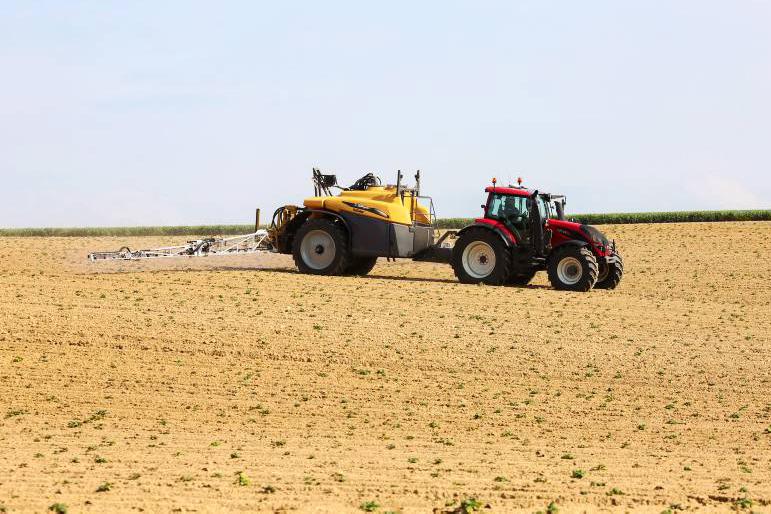
Self-propelled trailed sprayer from Challenger
Challenger will launch its first trailed sprayer at Agritechnica, in November 2015, the RoGator 300 series. Initially, there will be two 300 Series models – the RG333 and RG344. The last two digits refer to the tank capacity of 3,300 and 4,400 litres.
According to Challenger, the RoGator 300 shares two-thirds of its technology with the self-propelled RoGator 600 sprayer (hence its description as self-propelled trailed sprayer).
This includes the spray boom and suspension system, centre frame, boom lift arm (adapted slightly but the same concept), all plumbing and its chemical induction hopper.
What Challenger engineers have done is to add these to a specially-made drawbar, chassis, axle and tank.
Challenger says its trailed sprayer range will be available through all AGCO dealers – MF, Valtra, Fendt and Challenger.
Gold and silver medals awarded
Each exhibitor at Agritechnica is entitled to submit innovations to the DLG (German Agricultural Society) medal award system. Medals are highly regarded and sought after among the agricultural manufacturing community.
Once a submission is made, the DLG carries out intensive information analysis and discussion. An impartial committee makes a majority decision on which products are to be awarded a gold or silver medal.
Gold medals for innovations will be awarded for products with a concept showing new functions or which can improve known processes.
Silver medals for innovations will be awarded for products which have been developed further in such a fashion that an essential improvement of the function or the process may be expected. However, the product does not totally satisfy the criteria for the award of a gold medal for innovations.
This year, the DLG awarded five gold and 44 silver medals to exhibitors participating at Agritechnica. Below is a sample of those from both the gold and silver categories.
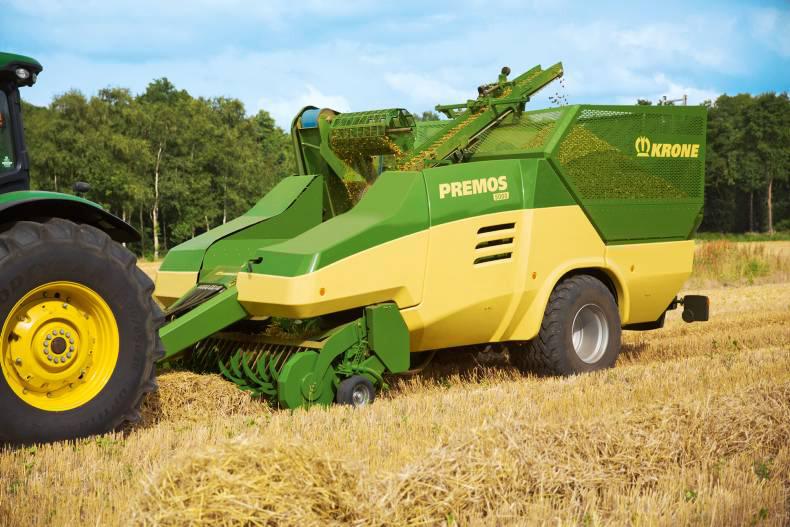
Krone PREMOS 5000 - gold award
Resembling a large square baler, Krone has developed a pelleting machine for making pellets out of straw in the field or the shed.
The Krone PREMOS 5000 picks up the swath of straw and uses two interlocking die-rollers to break down the straw into workable matter. A process that develops 2,000 bar pressure then converts this straw material into 16mm pellets.
According to Krone, 2.5kg of pellets is the equivalent of one litre of oil (in the context of a central heating system). Krone also says that 250g of pellets can absorb one litre of water in an animal-bedding scenario.
Production rate in-field is five tonnes per hour of pellets and the Krone PREMOS 5000 requires in the region of 400hp to operate it in the field.
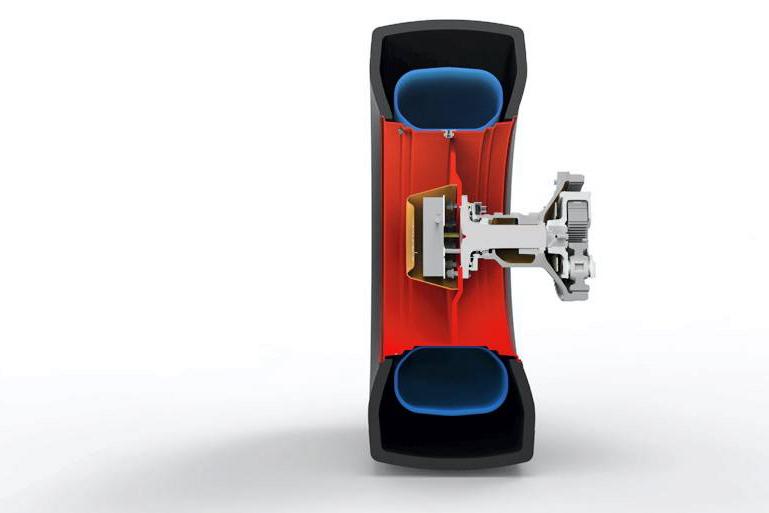
Fendt VarioGrip Pro - gold award
Fendt’s VarioGrip system provides an on-board central inflation/deflation system where the pressures of all four tyres can be adjusted from the in-cab Vario terminal. This is ideal when moving from road to field and back. But it can be very slow at reinflating for road-going operations; it takes seven to nine minutes per bar.
The Fendt VarioGrip Pro uses an additional high-pressure tyre inside the tractor’s existing rear tyre to act as a reservoir and rapidly re-inflate the outer tyre. This inner tyre was developed in conjunction with Mitas in the Czech Republic and can reinflate a rear wheel by one bar in approximately 30 seconds.
On the new VarioGrip Pro system, there is now just one rotary feed through for the pressure airline. Electric control and monitoring is done through a non-contact inductive system and operated by the tractor’s Vario terminal.

AmaSpot from Amazone - silver award
Targeted and variable rate application of pesticides is fundamental for viable crop production and saves a considerable amount of money by minimising the use of chemicals. A joint development by Agrotop, Amazone and Rometron, AmaSpot is an intelligent sensor-nozzle system that reduces spray rates in crop protection.
Detecting green plants against the soil background, the system is able to provide very localised application, saving 20%to 80% of the chemicals.
Using advanced infrared sensors (1), a unique and ultra-fast pulse width modulation (50Hz) and bespoke low-drift nozzles (2) on the Amazone Super-L boom, the system is able to detect green plants down to an accuracy of one square centimetre – by day or night and at speeds of up to 20km/h.
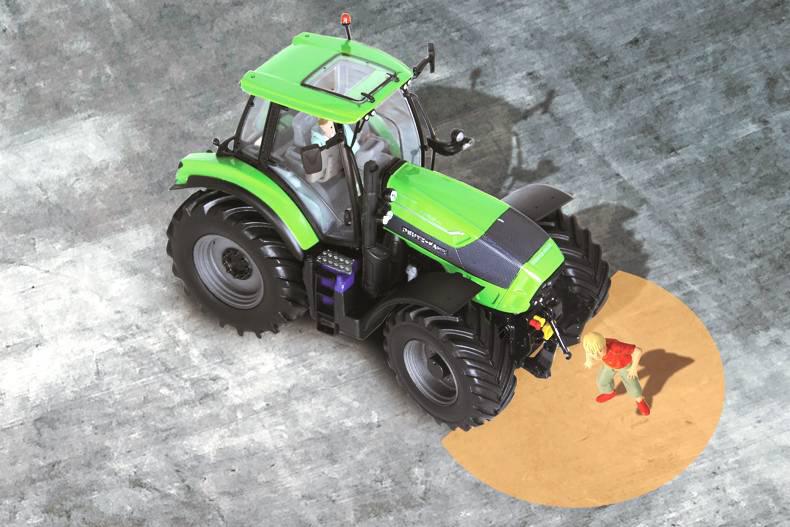
Driver Extended Eyes (SAME Deutz-Fahr) - silver award
Using a number of camera sensors installed on the tractor, Same Deutz-Fahr’s (SDF) Driver Extended Eyes system is able to detect a moving obstacle. A warning will pop up on the driver’s operator screen and prevent the tractor from moving. The system will be available from late 2016 on TTV (cvt) models and is currently in phase one of the systems development. SDF says it is working on phase two.
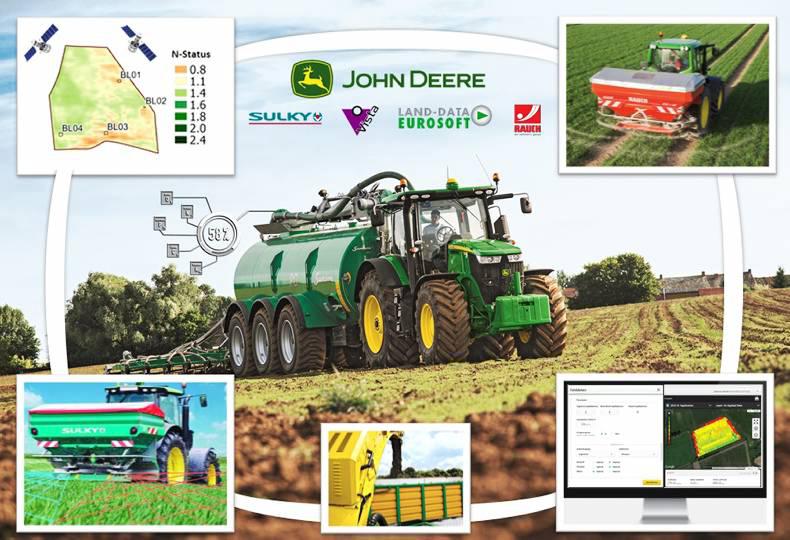
Connected nutrient management (John Deere*, Land Data Eurosoft, VISTA, Rauch and Sulky)
Maintaining the nutrient balance of the field from harvest to harvest involves extensive calculation and planning efforts for the farmer. Connected Nutrient Management is a user-friendly, optimised nutrient-management system enabling the demand-oriented, precise application of organic and chemical N and P fertilisers.
The system supports planning and optimisation with a holistic, overall observation of the harvest history and includes technologies for highly precise fertiliser application.
The data, knowledge and key technologies, owned by innovation partners John Deere, Land Data Eurosoft, VISTA, Rauch and Sulky, have been tied up in a smart, complete bundle to offer the user an agronomically optimised, site-specific nutrient application system complying with fertiliser application regulations. This ensures higher precision when planning and applying organic or artificial fertilisers.
At the same time, the system is a cost-cutter, optimising yields in terms of quality and quantity, while complying with the strict fertiliser regulations and offering site-specific documentation.
For the first time, farmers will be able to precisely determine, apply and document nutrient demands (nitrogen, phosphates, etc) for specific sub-areas, regardless of the type of organic or artificial fertiliser used.
Since nutrient distribution is optimised according to sub-area demands and vegetation times, it provides a higher level of nutrient efficiency and it also optimises nutrient balances.
There has never before been a similar integrated solution offering maximum customer value while proactively considering the prevailing environmental and legislative constraints.
*John Deere won two other gold medals in addition to its involvement with this one.




















SHARING OPTIONS